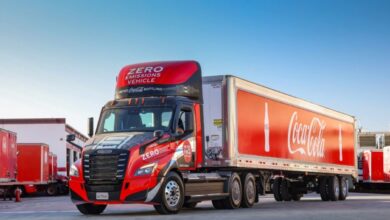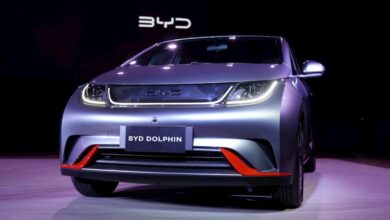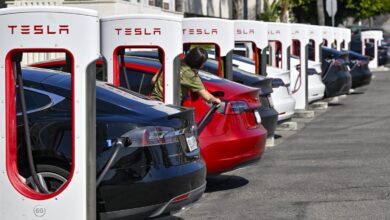GM’s Barra clarifies stance on EVs as shareholders question demand
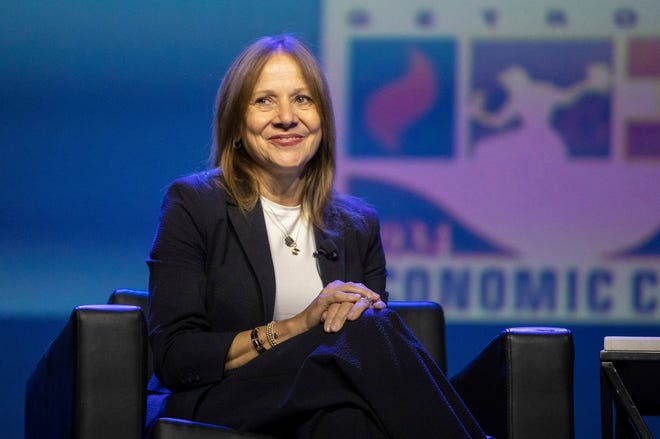
General Motors CEO Mary Barra stood firm on the automaker’s strategy to transition to electric vehicles even as some shareholders questioned market demand for the vehicles during GM’s annual shareholder meeting Tuesday.
Barra did soften GM’s stance on the timing to go all-electric, noting that ultimately, the composition of GM’s future vehicle lineup will be guided by customer demand. That’s an easing up from GM’s previous stance that all of its new vehicles would be all-electric by 2035.
Her comment came after a shareholder mentioned GM’s news last month, as first reported by the Free Press, that GM’s luxury brand Cadillac will likely not have an exclusively all-electric portfolio of vehicles by the end of the decade, which was an earlier target. Instead, it will continue to offer internal combustion engine vehicles too.
“This is great news for many motorists who are not excited by EVs,” the shareholder told Barra referring to Cadillac’s change. “But is this just a temporary thing or will GM continue to resist the political pressure to impose electric vehicles on the public?”
Barra replied: “We have a great lineup of gas-powered, or what we call ICE vehicles, that are available right now and we have a great lineup of EVs that will continue to grow. We’ll be covering the portfolio from a segment perspective and arranged perspective of pricing, design, et cetera. So we believe we’re well-positioned and we will be customer-focused as we go through this transformation.”
The comment was later flushed out in an interview with NBC when Barra said the automaker’s plan to turn its fleet all-electric will now play out “over decades.”
“We said back in 2018 that we’re committed to an all-electric future,” Barra told NBC Tuesday. “But as we make this transformation, it’s going to happen over decades.”
May the best month of EV sales ever
The shareholder meeting was conducted virtually with Barra taking some presubmitted questions and live questions from shareholders. The questions mainly centered on shareholder concerns about the slower-than-expected growth in EV demand. Some asked what GM is doing to help spur EV adoption since EVs underpin the company’s future.
Barra assured shareholders that EV sales are increasing, saying that May was GM’s “best month ever for EV sales in North America.”
Company spokesman David Caldwell confirmed that May was indeed GM’s all-time top-selling month for EVs saying it was mainly driven by “ongoing growth” for Cadillac Lyriq, Chevrolet Blazer EV, GMC Hummer EV and Chevrolet Silverado EV. Initial Chevrolet Equinox EV customer deliveries occurred at the end of the month too. GM will release a detailed sales report at the end of the second quarter on July 2.
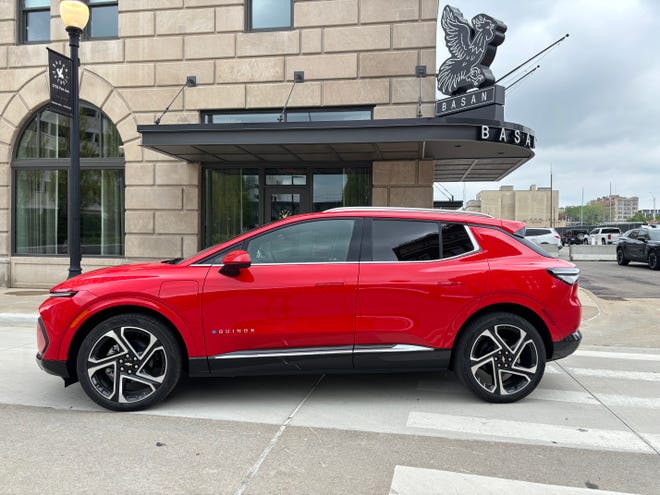
“We’re seeing profit improvement in our EV portfolio as we scale production of the broadest EV portfolio on the market, a portfolio purposely built to win new customers,” Barra said.
But she said GM is watching consumer demand closely and will remain nimble to adjust production to what consumers want, noting GM has a strong lineup of gasoline-powered vehicles, more new EVs on the way and plug-in hybrids coming in 2027.
“We believe we have the right products and strategy to win with customers to grow our volume and market share, however if the EV market develops more slowly than expected in the near term, we will be nimble to adjust our production to demand,” Barra said.
Watching EV demand closely
Barra said GM is still on track to achieve “variable profits” for its EVs in the second half of this year and it continues to target low-to-single digit pre-tax adjusted margin profits on its EVs in 2025.
GM currently sells the following EVs:
- Chevrolet Blazer EV
- Chevrolet Equinox EV
- Chevrolet Silverado EV
- GMC Hummer pickup and SUV
- Cadillac Lyriq SUV
Coming later this year are the Cadillac Optiq SUV, Escalade IQ SUV and GMC Sierra EV pickup.
“Like everyone, we are watching EV demand closely because the pace of adoption has slowed, but we still expect that 2024 will be a record year of EV sales continuing on a strong growth projectory,” Barra said.
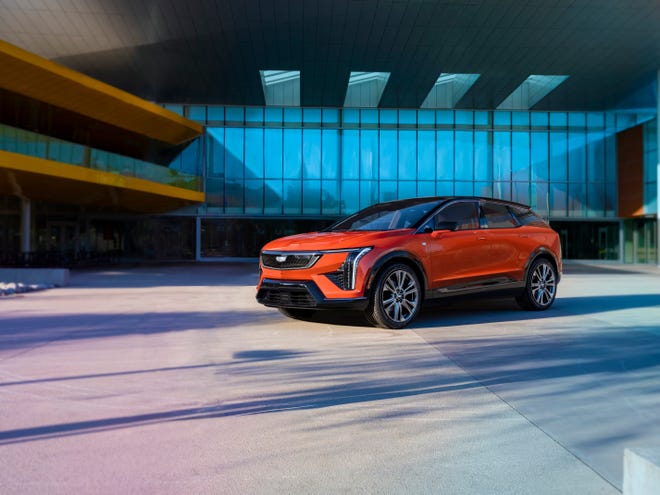
She said first-quarter retail registrations for EVs in the United States increased 9% from the year-ago period and that third-party forecasters expect EVs to make up10% of the U.S. car sales this year, which would be about 1.6 million vehicles.
But the first question from a shareholder was: “Recent market trends seem to indicate that EVs sales are slowing compared to ICE and hybrid counterparts. What action, if any, is GM taking to assist with consumer adoption?”
Barra answered that GM leaders anticipated there would be “ebbs and flows in EV adoption,” which is why GM offers a diverse portfolio of gasoline-powered vehicles, electric and soon plug-in hybrid vehicles.
How about fast-chargers at McDonald’s?
Another shareholder asked: “Has GM considered putting chargers at every McDonald’s?” The moderator said shareholders had several other questions about GM’s EV charging infrastructure.
Barra said GM continues to accelerate the installation of convenient and accessible public fast charging, and it’s continually improving. She said about 600 public fast-charger stations came online in the first quarter, an 8% increase from the year-ago period.
“There are now almost 800 fast charging stations across the country or one for every 15 gas stations,” Barra said. “We’re working with 12 charging networks and GM EV drivers have access to approximately 174,000 chargers and growing throughout the U.S. and Canada.”
Barra said GM is partnering with Pilot Flying J travel centers and fast-charging network EVgo to install DC fast chargers at 500 locations, 33 of which are now open with 200 more to open by the end of the year.
“These are designed for road trips on major highways with fast chargers under a well-lit canopy and restaurants, convenient stores, restrooms and lounges,” Barra said. “We’re working with EVgo to install 3,250 more DC fast chargers in the nation’s top 50 metro areas. About 1,000 are active now.”
GM is part of a joint venture with six other carmakers to install at least 30,000 addtional fast charging stations across North America, she said. GM, like Ford Motor Co., has an agreement with Tesla for GM EV drivers to have access to Tesla’s Supercharger network of 15,000 chargers. That starts later this year for GM EV owners, Barra said.
“Our team is also delivering solutions to help our EV drivers charge at home and leverage their EVs as a home power source through bidirectional charging,” Barra said. Customers in Michigan can now purchase GM Energy V2H bundle for about $7,300.
EV adoption is dependent on charging, she said, adding, “There’s certainly more to come here.”
Compensation changes needed
As the Free Press first reported in February, GM told its salaried workforce it was changing how it determines bonuses for salaried employees. Starting this year, the automaker will include the performance of EVs, software and services and autonomous vehicle programs in the formula that determines white-collar workers’ bonuses.
GM’s board is aligning those same metrics with top executives. But one shareholder proposal asked the board to eliminate EV targets in the incentive compensation programs. Shareholders rejected the proposal, an outcome Barra favored, noting that the new compensation plan will attract the best talent to help GM succeed in its transition to EVs and self-driving technology.
“I want to emphasize our commitment to grow our EV business profitably,” Barra said. “As you know the board did redesign the compensation plans for 2024 and I believe these changes are already helping us drive execution and attracting new talent.”
More:New UAW report details Fain’s 2023 salary, union expenses, shows declining membership
More:GM promotes 2 former Apple execs to develop, advance its software
Contact Jamie L. LaReau: jlareau@freepress.com. Follow her on Twitter @jlareauan. Read more on General Motors and sign up for our autos newsletter. Become a subscriber.
